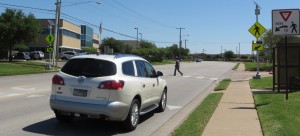For many pedestrians, crossing a multilane busy roadway without the protection of a traffic signal is a nerve-wracking proposition, even when using a crosswalk. Help is coming, though, as research into a recently-developed rapid-flash beacon has shown significantly positive results—an increase in the number of drivers yielding to pedestrians. One of those projects is a study sponsored by the Federal Highway Administration (FHWA) and conducted by the Texas A&M Transportation Institute (TTI) aimed at finding more effective ways to alert drivers to pedestrians crossing streets.
“The device we tested is very effective,” said TTI Senior Research Engineer Kay Fitzpatrick. “A study conducted about 10 years ago found that you had to have a device that showed a red indication for drivers to yield at a high enough rate to be considered acceptable. Now with this rapid-flash beacon, there is a device with a yellow indication where drivers are yielding in the 80 percent range.”
Before adding this device to the Manual on Uniform Traffic Control Devices, desired is a better understanding of why it is so much more effective than other devices with yellow beacons. This FHWA study focused on the flash pattern being used. The TTI team developed a temporary light bar and controller that permitted the research team to have control over several of the beacons characteristics, such as flash pattern and brightness. There were three flashing light patterns selected for use with the temporary light bars which were installed on existing pedestrian crossing signs. The patterns included the pattern currently being used with other installations along with two patterns developed by TTI in collaboration with FHWA and other transportation professionals.

The study included eight sites, located in either College Station or Garland, Texas. Most of the sites had 4 lanes (seven sites) with a 40 or 45 mph posted speed limit. The remaining site had 2 lanes and a 30 mph posted speed limit.
The research team used a staged pedestrian approach to evaluate driver yielding for the different patterns. Under this protocol, a member of the research team acts as a pedestrian using the crosswalk, to stage the conditions under which driver yielding would be observed. Each staged pedestrian wore similar clothing (gray t-shirt, blue jeans, and gray tennis shoes) and followed specific instructions in crossing the roadway. The staged pedestrian was accompanied by a second researcher, who observed and recorded the yielding data. The overall average driver yielding for each of the three patterns was between 78 and 80 percent. The statistical evaluation found no difference in effectiveness between the three patterns.
“There are many theories as to why this device is more effective than other yellow devices. It could be the brightness or that the LEDs are only active when a pedestrian pushes the button rather than having the yellow beacons continuously flash,” said Fitzpatrick. “But the bottom line is that drivers in greater numbers are now noticing the flashing beacon and yielding to pedestrians crossing the roadway.”
For more information about this project, please read the Executive Summary.